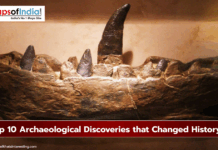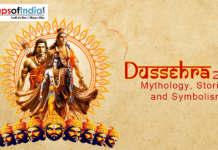“A tomb now suffices him for whom the whole world was not sufficient.”
—- Anonymous
How do we remember the great Maurayan king Ashoka. Many books call him as prodigious,idealistic, a victorious king and some even a monk or a hermit. Blinded by the statues and buddhist edicts can we afford to ignore the alter-ego of Ashoka,the great. The Janus- faced emperor should rather be rememberd for his mass genocide.
The agressive, barbarous and blood-thirsty Ashoka truly represents the national emblem with ferocious lions. Ironically, the Ashokan chakar represents his unending terror and mascare. The total renunciation adopted by the emperor was not his moral choice but could have been his only choice. It was only Kalinga which stood between his ultimate glory and his immortality. Drunk with desire and blood, the emperor slaughterd his dream to victory. The powerful yet weak willed man gave way to his greed by killing many husbands, numerous sons and innumerable brothers.Finally he realised that he made his mark from Iran to South India but it struck him that if the coming generation would remember him as an honourable king or a heartless hellion. The brutal and pitiless emperor deliberately adopted Devanampiya Piyadasi which means “Beloved-of-the-Gods, He Who Looks On With Affection.”
Can the merciless emperor be forgiven for his evil deeds. Was Ashoka able to prove himself as innocent just by adopting buddhism. Ashoka had a naive understanding of Buddhism. He was ruled by the fact that erection of edicts and statues would lead to forgiveness and redemption. Did he forgot the differnce between preaching and practicing. The researchers have suggested that Ashoka’s edicts say nothing much about Dharmma and its teaching. In all the edicts what one can find is his plea for absolution.
Ironically ,Ashoka never inherited the qualities of rightesouness from his mother named,Dharma. Ashoka since childhood was known for his callous and brutish behaviour between his several older half brothers. His savage and stony acts could be seen in his acts of hunting in his ‘innocent’ childhood. Ashoka actually constructed a harem of 500 women. When the women denied to his demands he actually burnt them to death. This act owned him the name of Chand Ashoka, meaning Ashoka the Fierce. Untamed by blood Ashoka could have never attained true enlightenment.
The edicts of the emperor-of-emmperor stands testimony not to benevolence, humanity and to his philanthropic nature but to his cowardliness and fearfulness; fearfulness for his karma and his rememberance as a cannibal and ogre. The edicts in Afganisthan, Pakistan , India and Nepal warrant his actual greed for power as they stand as a mark for his conquest and annex over his avarice for land. The statues are nothing but hellish labyrinth of his mind.



